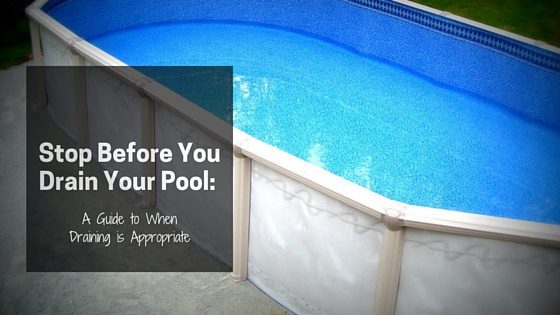If you’re the kind of person who likes to store the summer clothes out of sight before pulling out your winter wardrobe, put burlap around your cedars and draw sharp lines around your seasons, you might be tempted to drain your pool to get it ready for winter. Before you perform unnecessary pool maintenance that might be – ahem – more than a little draining, read this guide to when draining a pool is appropriate.
A pool is rather like a fish tank…
In that draining is NOT the way to clean it. Swimming pools don’t actually need to ever be drained, which may come as a huge surprise to overzealous pool owners. Even if your pool water is absolutely gross, a thorough cleaning regimen of vacuuming, filtration, and several days of shocking the water, should be sufficient.
But I don’t actually mind draining a pool.
Ah, to start over with entirely fresh water…sounds lovely, right? Unfortunately, draining your pool for the wrong reasons (like deep cleaning) can actually cause great damage to your pool structure and liner – which surely isn’t what you had in mind. Why is pool draining so tricky? Here’s what can go wrong:
- When too much pool water soaks into the ground, the resulting upward water pressure could crack the bottom of your pool or cause it to float right out of the ground.
- In the case of fibreglass pools, the floors can split altogether, necessitating repairs to the fibreglass shell, plumbing, side walls (which can bulge outwards or even pop as a result of the sudden lack of water pressure), and pool deck.
- On both inground and aboveground pools, the liner can shrink when the pool is drained, then tear when the pool is refilled. Refilling promptly and shifting the liner in the early stages of refilling can mitigate this. This is not a good idea with older liners.
- Excess ground water can cause pool liners to float away from the walls causing wrinkles.
Wait…won’t the hydrostatic valve compensate? The short answer is no even if you have one. That valve was never designed to compensate for complete drainage of the pool.
So when can I drain the pool?
Draining a pool is necessary on occasion. During liner replacements, or to fix tiles, paint or refinish the pool surface. But be sure you time draining a pool with the arrival of the milder seasons to prevent harsh and fluctuating temperatures from damaging liners or high water tables. And never drain a pool after storms have added a significant volume of water to it.
During the winterizing process typically the water level will be dropped to just below the return jets. This is usually ok for most pools. If you have a high water table we recommend using duck plugs in the inground pools to prevent any liner damage. Additionally those using an autocover as a replacement for a winter cover should also use duck plugs to prevent undue strain on the cover.
Other reasons to drain your pool include necessary repairs, releveling a pool base, or to decrease a high concentration of Total Dissolved Solids (TDS). Always speak to a professional first to determine whether draining a pool is really necessary, then to learn how to drain a pool yourself — if you feel up to the challenge and are ready to do the research and work required to avoid causing more harm than good. Not your thing? Leave it to the pros.


1 Comment
Why You Should Never Drain Your Pool Yourself | Certified Leak Detection of Orlando
[…] aptly stated by the good people at R&R Pools, a pool is rather like a fish tank in that draining is not the way to clean it. “Even if your […]